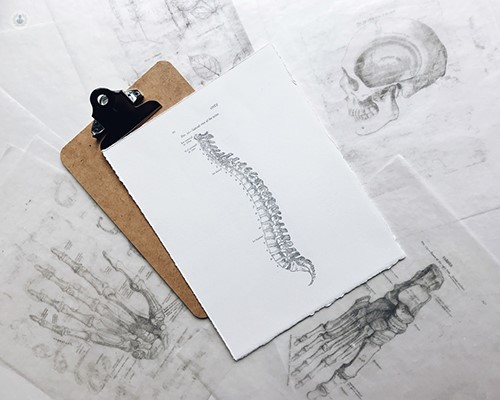5 different types of spondylolisthesis
Escrito por:Spondylolisthesis is when a bone in the spine (vertebra) slips out of place, usually forward relative to the one below it. There is a misconception that spondylolisthesis is related to, or is in fact, a slipped disc, which is not true. A slipped disc is a rupture of the spinal disc between the vertebrae. Some patients who visit the London Neurosurgery Partnership are diagnosed with the condition but have no idea what it is. Mr David Bell, one of the clinic’s complex spine surgeons, explains what spondylolisthesis really means, the symptoms it causes and how it is treated.

What are the different types of spondylolisthesis?
There are five major types of spondylolisthesis, which include the following:
- Dysplastic spondylolisthesis – a congenital defect where part of the vertebra called the facet causes it to slip forward.
- Isthmic spondylolisthesis – a defect in the vertebra, which can cause it to slip.
- Degenerative spondylolisthesis – due to ageing and arthritic changes in the joints.
- Traumatic spondylolisthesis – a sudden injury or trauma such as a fracture to the spine.
- Pathologic spondylolisthesis – a weakness in the spine, possibly caused by bone disease such as metastatic disease, tumour, osteoporosis etc.
What are the typical causes of spondylolisthesis?
The causes of spondylolisthesis do vary as some people are born with a defective vertebra and if no symptoms, the condition may not be identified until later in life. Other causes are more identifiable such as:
- Sports injury such as gymnastics
- Degeneration (ageing or overuse)
- Tumour or illness
- Sudden injury or trauma
- Birth defect
- Surgery
What are the symptoms of spondylolisthesis?
Spondylolisthesis can carry quite common symptoms and therefore many people do not realise that they have this condition. These include:
- Lower back pain
- Pain and/or weakness in one or both legs or thighs
- A tingling sensation that radiates from the lower back down to the legs.
- Tenderness or stiffness in the back
- Tight hamstring and buttock muscles
- Excessive curving of the spine known as lordosis
- Difficulty walking or running
What are the non-surgical options to treat spondylolisthesis?
There are many ways to treat spondylolisthesis. Initial treatment could be simply avoiding back-straining activities such as lifting, bending or sports, giving the back a chance to return to normal. If that does not show much progress then an introduction of anti-inflammatory painkillers such as Ibuprofen, or something stronger, may be required to help reduce the pain and inflammation.
If the above is of no use or not proactive enough then the doctor may recommend some physiotherapy. Stretching out the hamstrings and the lower back may really help strengthen and increase the motion in the back.
Another non-surgical method is corticosteroid injections. This may be used for patients who are suffering from symptoms of back pain, numbness and tingling. The injection will be placed around the affected nerve.
What are the surgical options?
Surgery is the last resort. If the above non-surgical treatments are ineffective and the patient is still suffering from symptoms or it is severe and persistent, then the specialist may take them down this route. Another reason for surgical intervention would be because of severe damage resulting from trauma.
Depending on what type of spondylolisthesis the patient has deciphers the surgical procedure that is needed. Usually, a decompression (laminectomy) and a spinal fusion with pedicle screw instrumentation are required. This can be discussed in detail with the doctor as the surgery will be tailored to the individual patient.


